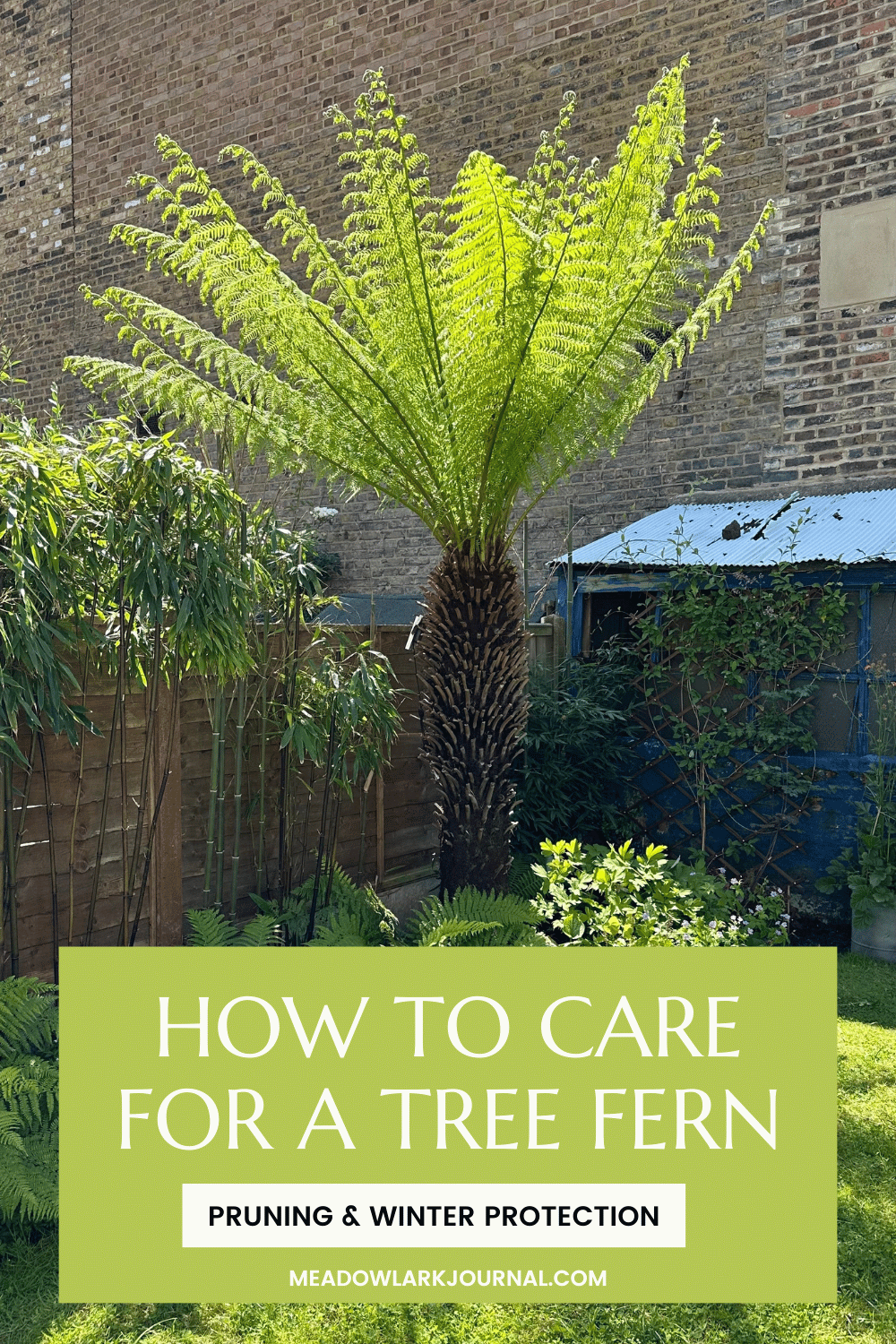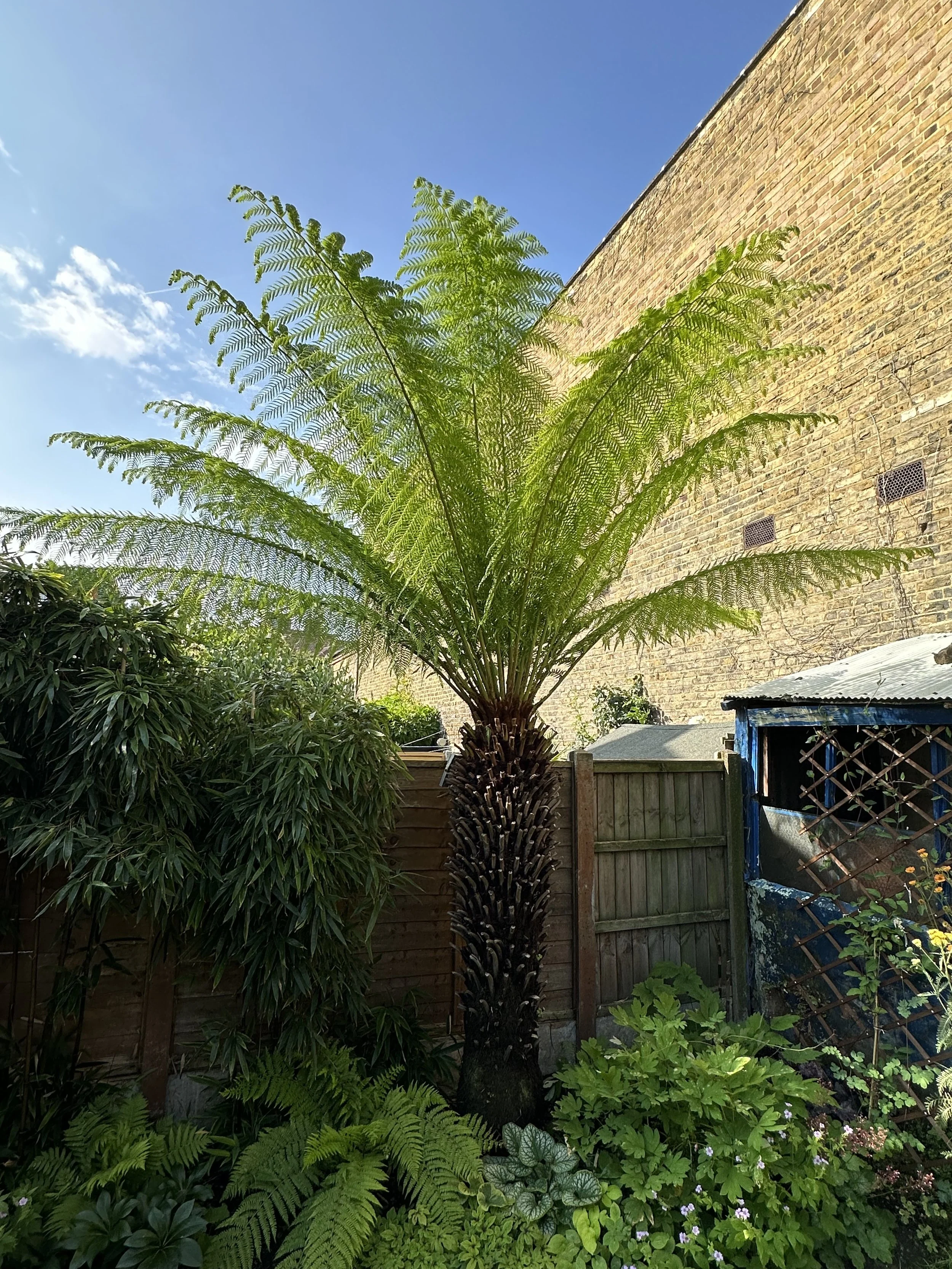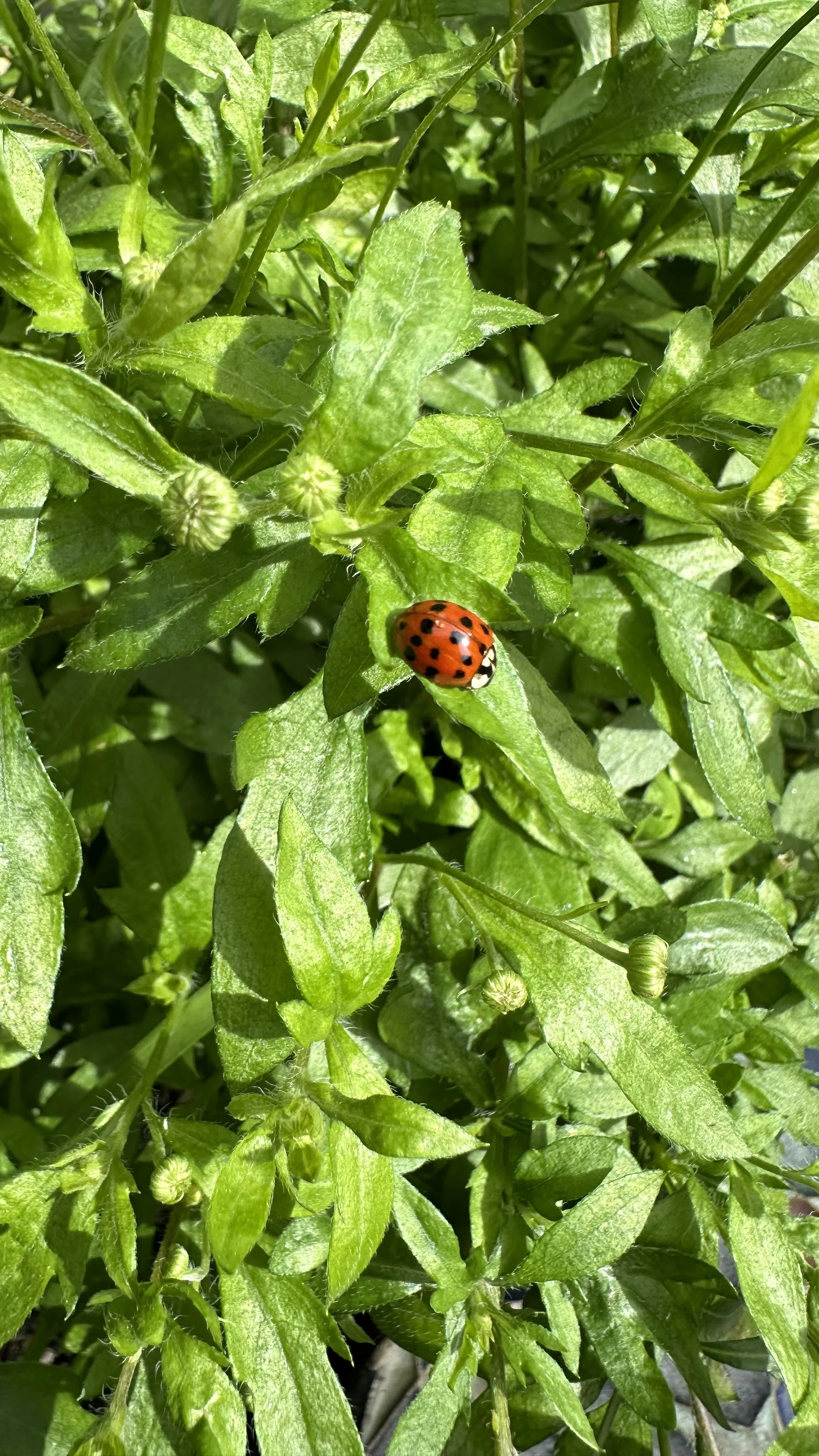Tree Fern Care: From Pruning to Winter Protection
This website is reader-supported - thank you! This post may contain affiliate links. As an Amazon Associate, I earn from qualifying purchases at no extra cost to you.
Tree ferns are one of those plants that instantly bring a little tropical feeling to a garden.
Originally from temperate rainforests of southeastern Australia, they thrive in spots that get plenty of moisture and not too much direct sunlight.
They work especially well in those tricky, shady corners of a garden.
My own tree fern in the backyard is my pride and joy, but I’ll be the first to admit, they do need some special care.
Whether you’re keeping yours in a pot, or out in the garden like mine, I’ll share all the tips and tricks I’ve learned along the way.
For more fern-growing inspiration, check out my guide:
My Australian Tree Fern (Dicksonia antarctica).
Watering Your Tree Fern
Watering your tree fern is one of the most important things you can do to keep it happy, but it’s all about finding that balance.
Tree ferns love moisture, but they don’t want to sit in soggy soil.
Water the Trunk and Crown:
What is unique about watering tree ferns is it's important to pay attention to the crown and trunk of the fern.
Tree ferns have roots on their trunks.
These roots, called "aerial roots," grow along the trunk and are used to help the fern absorb moisture and nutrients from the air.
The trunk of a tree fern, especially in species like Dicksonia antarctica, is often covered with these roots, which can give it a slightly fuzzy or fibrous look.
These roots help the fern thrive in its native, humid rainforest environments, where there is a lot of moisture but the soil might not always be deep or rich.
It's important to keep the trunk moist, as these aerial roots rely on that moisture to stay healthy.
Here’s how I like to do it:
Gently water the crown of the fern. Be careful not to drown the crown—just give it a nice, light soak so the plant gets moisture where it needs it most.
Gently water the trunk, letting water trickle down to the roots. If your tree fern is mature, the trunk will have a slightly fibrous texture, and it will help trap moisture.
Check for Watering Puddles:
After watering, check to make sure there’s no standing water in the pot or around the base of the plant.
Standing water can lead to root rot, so if you notice puddles, make sure they drain away.
In general, your tree fern will need more water during warmer months when it's actively growing.
In winter, you can cut back a bit, as the plant goes into a more dormant phase. I normally don’t water mine at all in winter.
Just make sure the soil doesn't dry out completely.
For more growing tips for shade gardens, check out my guides:
Tree Fern Fact:
Fossil records suggest that tree ferns first appeared on Earth approximately 180 million years ago.
This means that tree ferns have been thriving on our planet since the time of the dinosaurs.
My tree fern right before I started pruning the old fronds.
Tree fern after old fronds have been pruned.
How to Prune Old Fronds
Pruning your tree fern is really easy.
Over time, older fronds will naturally start to fade, turning brown or yellow.
While it’s totally normal for the fern to shed these fronds, giving them a little trim can actually help your plant focus on new growth and keep it looking sharp.
Here’s how I like to do it:
Grab Your Tools:
First, grab a clean pair pruning shears or loppers.
Since my tree fern is quite large, I use loppers.
Trust me, using clean, sharp tools makes all the difference.
Dull shears can tear the fronds, which isn’t great for the plant.
Find the Old Fronds:
Look for fronds that are completely dead, yellowing, or browning.
These are the ones you’ll want to prune.
Don’t worry, you don’t need to touch the fresh, healthy fronds—those are doing their job!
Cut Close to the Base:
When you’re ready to prune, cut the old fronds as close to the trunk as possible without hurting it.
You can follow the natural curve of the frond and make the cut just above where it meets the trunk.
Be careful not to cut into the trunk itself—it’s where all the new growth is coming from!
Clean Up the Area:
Once you’ve finished, take a moment to clean up any leftover fronds or debris around the base of the plant.
It’ll help avoid pests or mold from creeping in.
For more shade garden tips and ideas, check out my guides:
Fertilizing Your Tree Fern
Fertilizing your tree fern isn’t something you need to stress over, but a little feeding during the growing season can do wonders for your plant.
Think of it as giving your fern a little boost.
Tree ferns aren’t heavy feeders, so you don’t need to load them up with fertilizer every week.
In fact, over-fertilizing can be harmful.
Too many nutrients can burn the roots and leave your fern looking a little worse for wear.
So, less is definitely more when it comes to feeding!
During the growing season (spring and summer) your fern will appreciate a light feeding only every 4 to 6 weeks.
A slow-release, balanced organic fertilizer works best, as it gives the plant a steady supply of nutrients without overwhelming it.
If you prefer liquid fertilizer, dilute it to half strength to avoid overfeeding.
Applying it during watering is an easy way to keep things simple.
In the fall and winter, you can cut back on fertilizing entirely.
Your fern isn’t actively growing as much during the colder months, so it doesn’t need as many nutrients.
Just focus on maintaining good soil moisture and humidity, and let the fern rest until spring rolls around.
If you notice that your fern’s fronds are starting to look a little pale or yellowing, it could be a sign that it’s time for a little extra feeding.
On the flip side, if the fronds are turning brown or curling up, it might be a sign of overfertilizing, so ease back a bit.
In short, think of fertilizing as a little seasonal treat for your tree fern—just enough to keep it healthy, but not so much that it overwhelms it.
For more ideas for your shade garden, check out my guides:
New fronds emerging from my tree fern.
Winter Care for Your Tree Fern
Winter might make you think of rest and dormancy for your tree fern, but don't be fooled—while your fern does take things a bit slower during the colder months, it still needs a little attention.
If your tree fern is outdoors, you’ll need to give it a little extra protection from the cold.
While tree ferns are pretty tough and can handle a bit of frost, freezing temperatures can still damage the delicate fronds.
To keep your fern cozy, wrapping it in a frost cloth works great.
If your tree fern is in a pot, try moving it to a more sheltered spot, like near a wall or under a tree canopy, where it’s not as exposed to the wind.
If you’re really in a colder zone, consider adding a layer of mulch around the base to protect the roots from freezing.
One of the biggest things to remember is that, while winter means a slower growth period for your tree fern, it’s still a time for it to recharge.
Don’t be tempted to overwater or fertilize too much.
Giving it the right balance of moisture and cool temperatures is just enough to help it rest and get ready for the growing season ahead.
For more ideas, check out my guide:
New fronds emerging from the crown. A good sign that it is time to prune off the old brown fronds.
Common Tree Fern Problems
Tree ferns can occasionally run into a few bumps along the way, but don’t worry—they’re pretty resilient, and most problems are easy to address once you know what to look for.
Let’s go over a few common issues and how to help your fern bounce back.
Yellowing Fronds
One of the most common problems you might notice with your tree fern is yellowing fronds.
It can be a little alarming at first, but usually, it’s a sign that your fern needs a little attention.
Yellowing can happen for a few reasons, but the most common culprit is overwatering.
When the soil stays too wet for too long, the roots can’t breathe, and this can cause the fronds to yellow or even wilt.
Make sure your fern’s pot has proper drainage, and check the soil before watering to ensure it’s not too soggy.
If you’ve been overwatering, allow the soil to dry out a bit before giving it another drink.
Another reason for yellowing could be a lack of nutrients.
Tree ferns do like a little feeding during the growing season, so if you haven’t been fertilizing, that might be the issue.
A light dose of balanced fertilizer can help bring those fronds back to life.
Browning or Wilting Tips
If you notice the tips of your fern’s fronds turning brown or curling up, it could be a sign that the air is too dry, especially if you are growing your tree fern indoors.
Tree ferns love humidity, so when the air gets too dry—often in winter when heaters are running—it can cause the fronds to suffer.
You can remedy this by increasing humidity around the plant, whether that’s by using a humidifier or simply misting the fronds every so often.
If you’re growing your fern outdoors, make sure it’s in a shady spot where it’s not exposed to hot, dry winds.
Pests
Pests can sometimes be an issue, though it’s not something you’ll have to worry about too often with tree ferns.
Aphids, scale insects, and mealybugs can sometimes make an appearance, especially if your fern is stressed.
If you notice tiny insects or sticky residue on the fronds, it’s time to check for pests.
You can gently wipe the fronds with a damp cloth to remove any pests, or treat your fern with an insecticidal soap or neem oil to keep the bugs at bay.
It’s best to catch pests early before they start to spread.
Root Rot
Root rot can be a real issue if the soil doesn’t drain properly or if the fern has been sitting in water for too long.
This can often happen when growing tree ferns in pots.
If you notice that your fern is looking a bit sad, with yellowing fronds or a general lack of growth, it could be a sign that the roots are rotting.
To check, carefully remove the plant from its pot and look at the roots.
Healthy roots are white or light brown, while rotting roots will look dark and mushy.
If root rot is the problem, you’ll need to trim away the damaged roots, repot your fern in fresh, well-draining soil, and make sure it’s not overwatered moving forward.
Stunted Growth
If your fern’s growth seems to have slowed down or stalled, it might be a sign of a few things.
It could be due to a lack of sunlight, too much direct sun, or for potted tree ferns it could be that it simply has outgrown its current pot.
Check to make sure it’s in a spot with the right amount of light—indirect or filtered light is best—and make sure it has enough space to grow.
If your fern has outgrown its pot, it might be time to repot it into something larger.
Tree ferns grow really well in east facing gardens.
Learn more in my guide:
New fronds starting to extend and relax.
FAQS
Can I grow an Australian tree fern indoors?
Yes, Australian tree ferns can be grown indoors.
Just place them in a bright room with indirect sunlight and maintain high humidity.
Keep the soil moist and reduce watering during the winter months when the plant is less active.
How do I propagate a tree fern?
Tree ferns are typically propagated through spores, though it’s a slow process.
You can collect spores from the underside of mature fronds and sow them in moist, well-draining soil.
Keep the soil humid and provide indirect light for the spores to germinate.
For more tips on gardening gear, check out my guide:
Wrap Up
With the right plant care—like finding a spot that’s not in direct sunlight, watering just right, and giving it a little love here and there—your fern will thrive for years.
Whether you’re following this growing guide for a tree fern you already have or you’re adding one to your garden, these plants bring a special touch to any space.
Gardening with tree ferns might take a bit of trial and error, but with a little patience and attention, you’ll soon be enjoying the tropical vibe they will definitely add to your space.
Pin this post to save it for later!












































